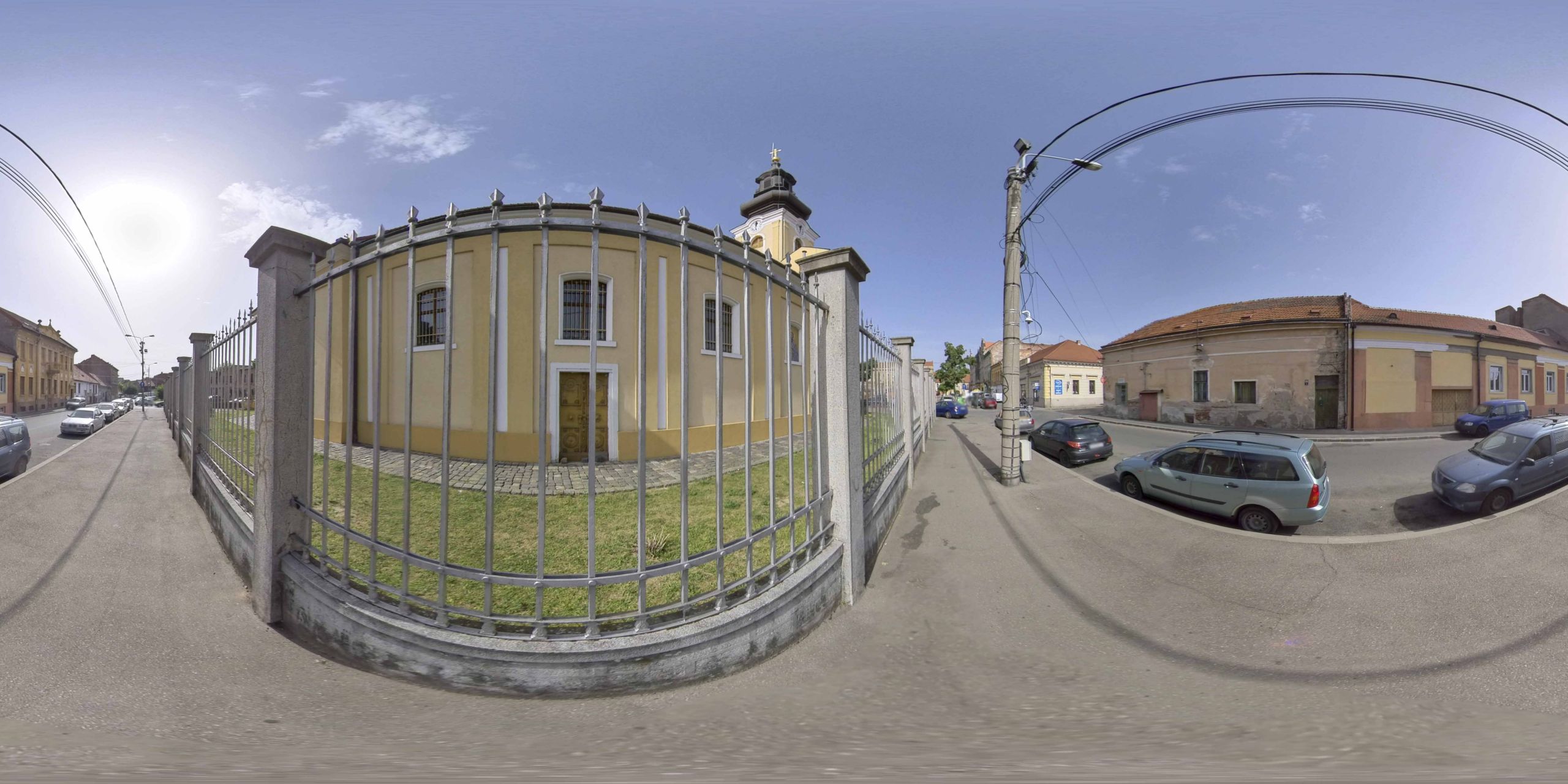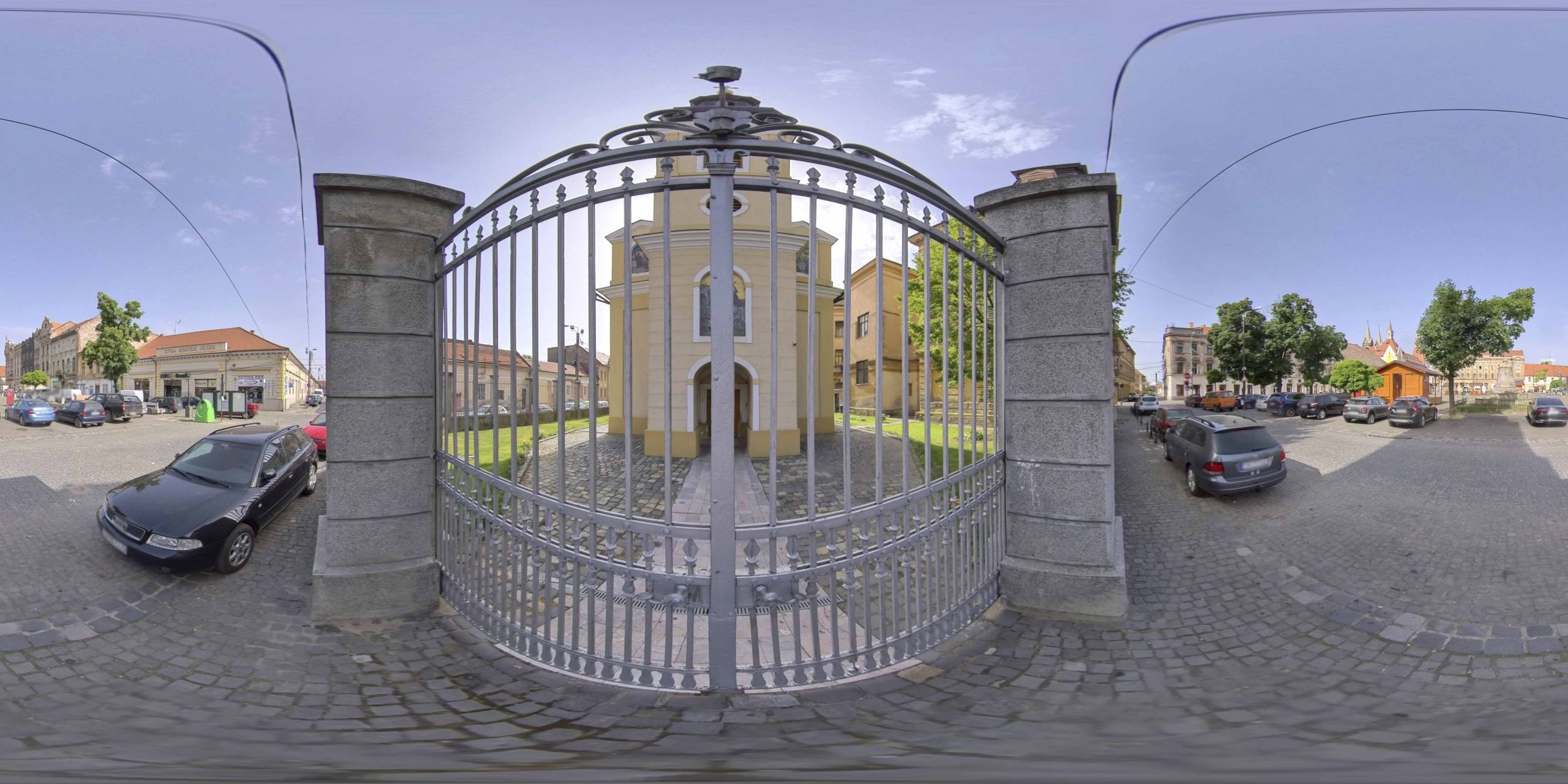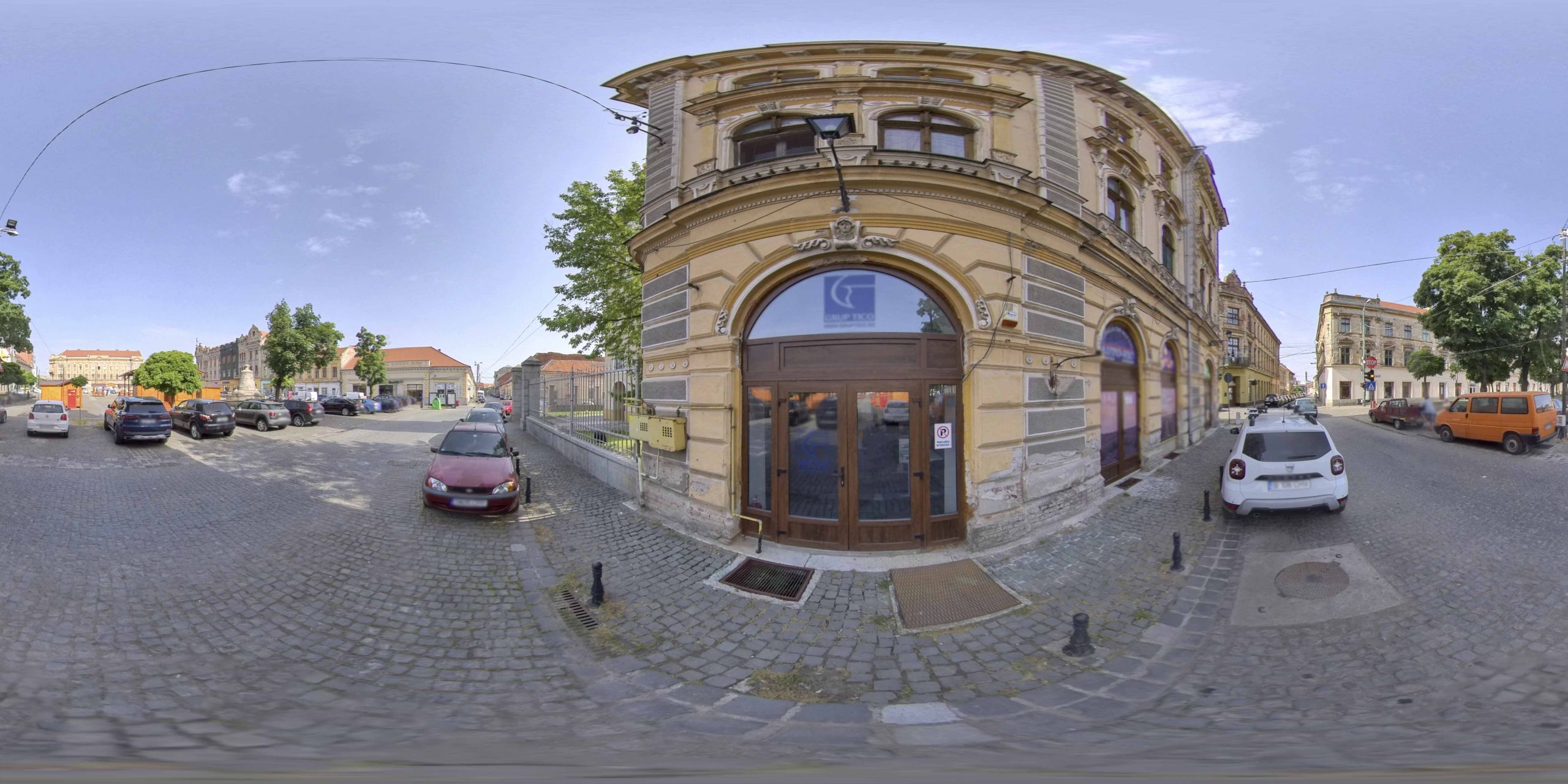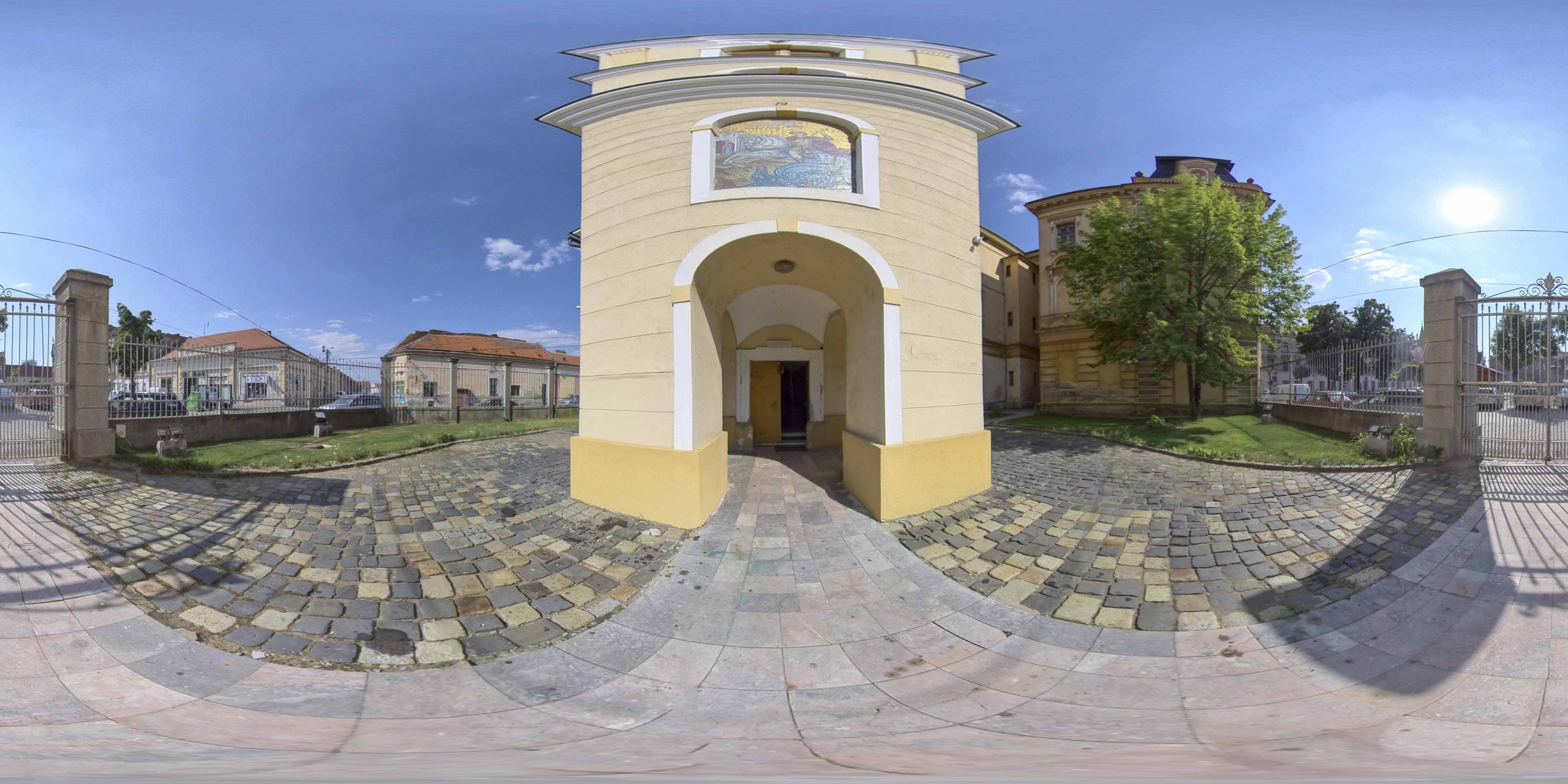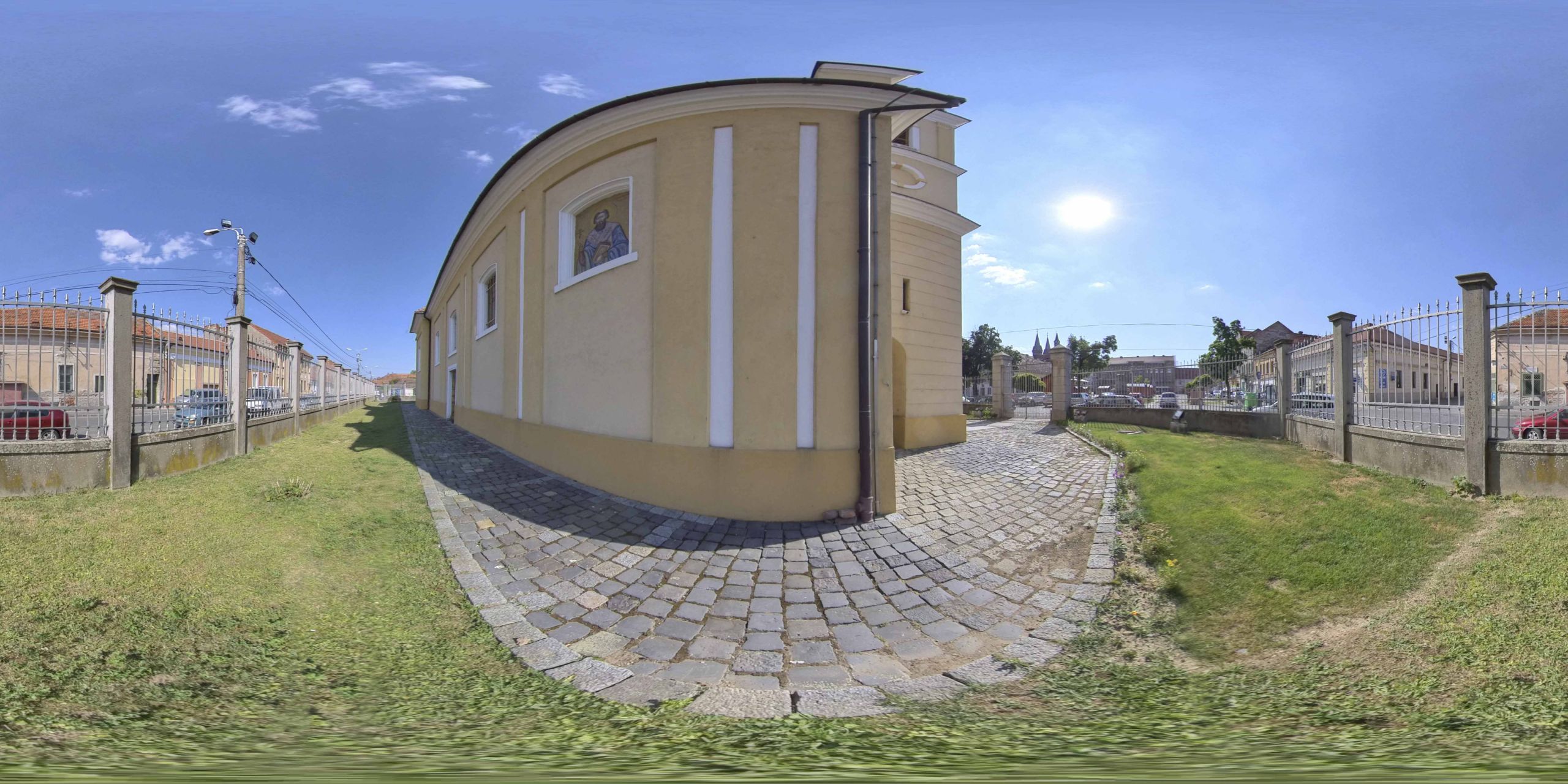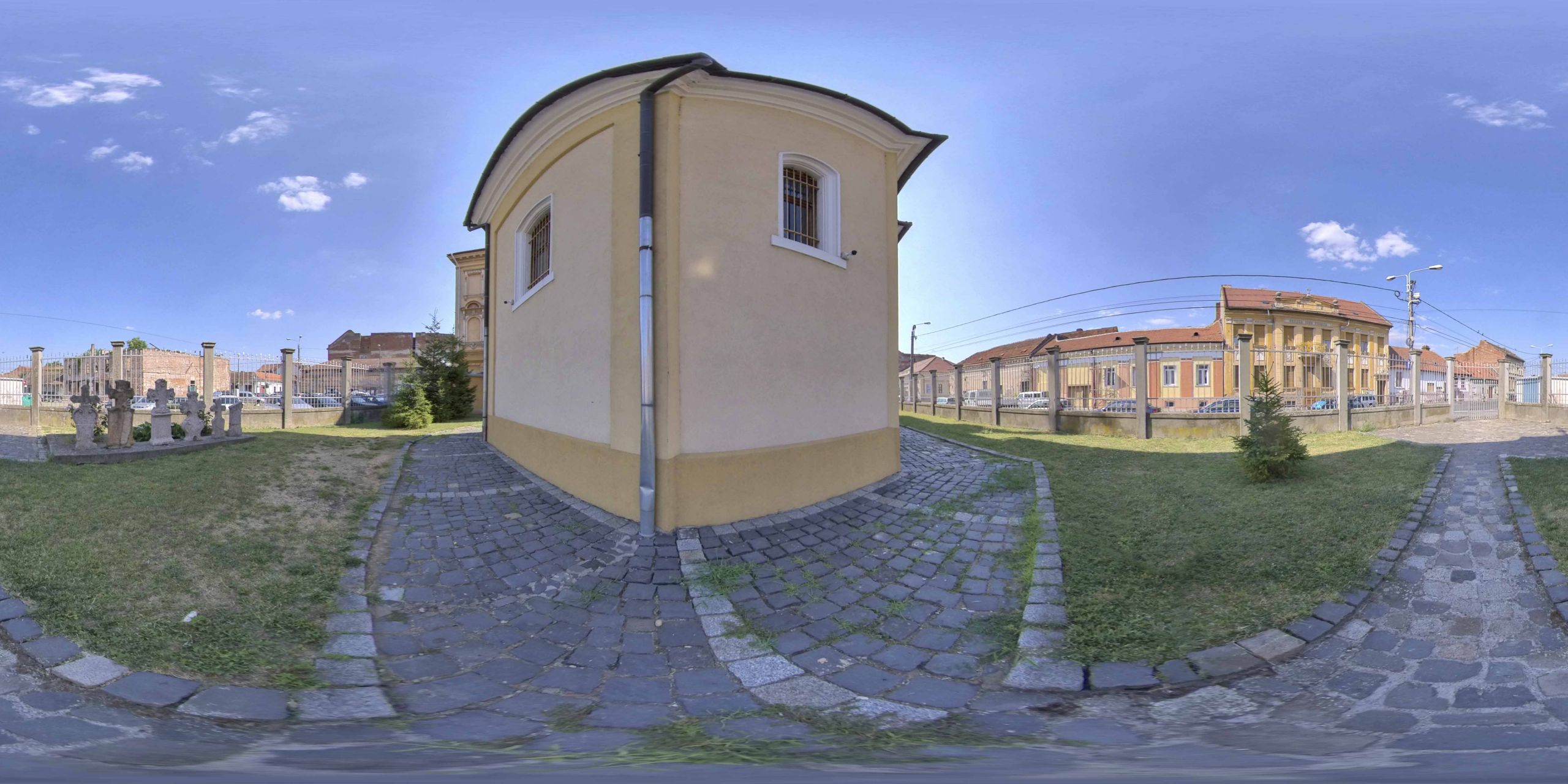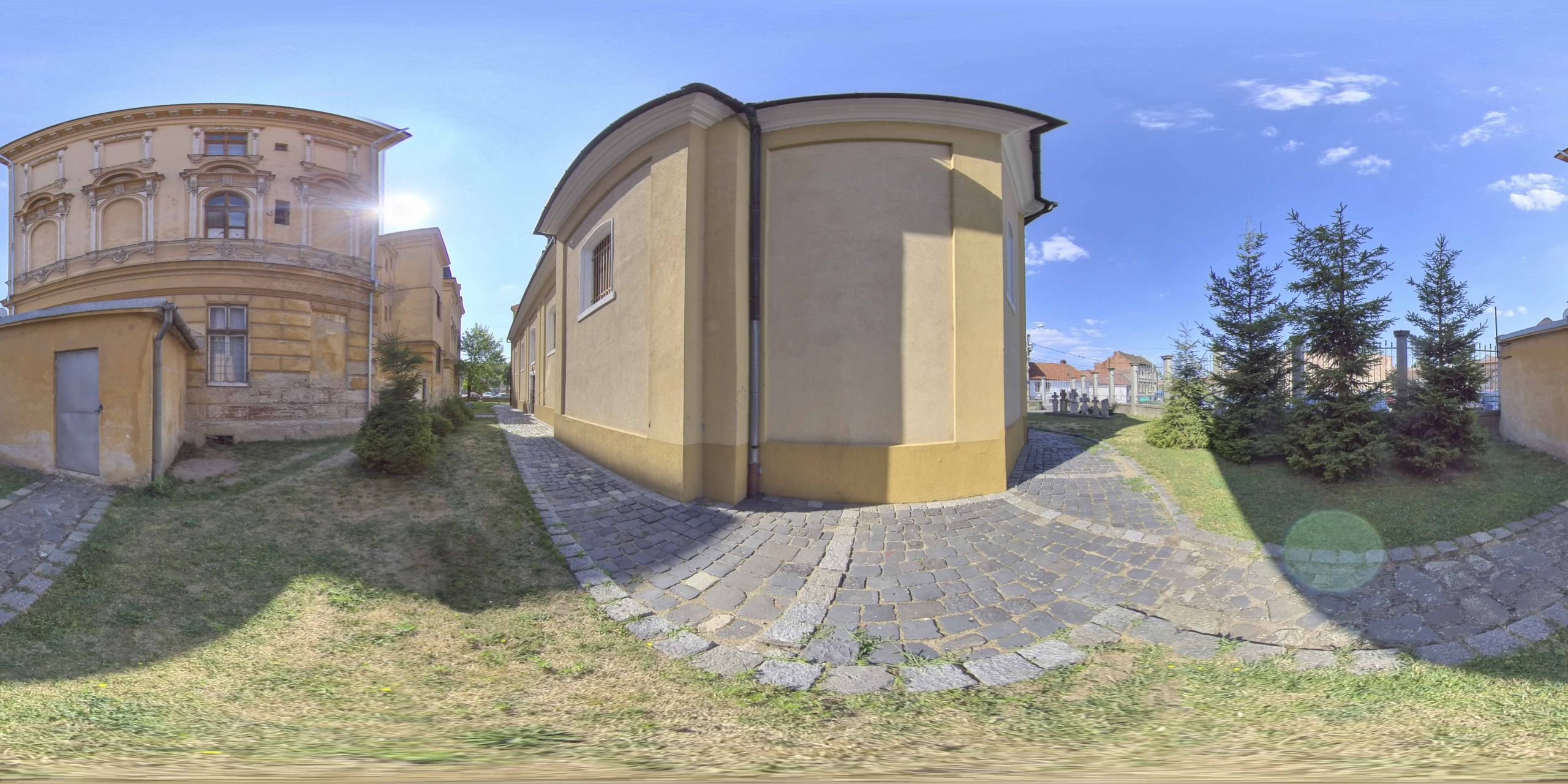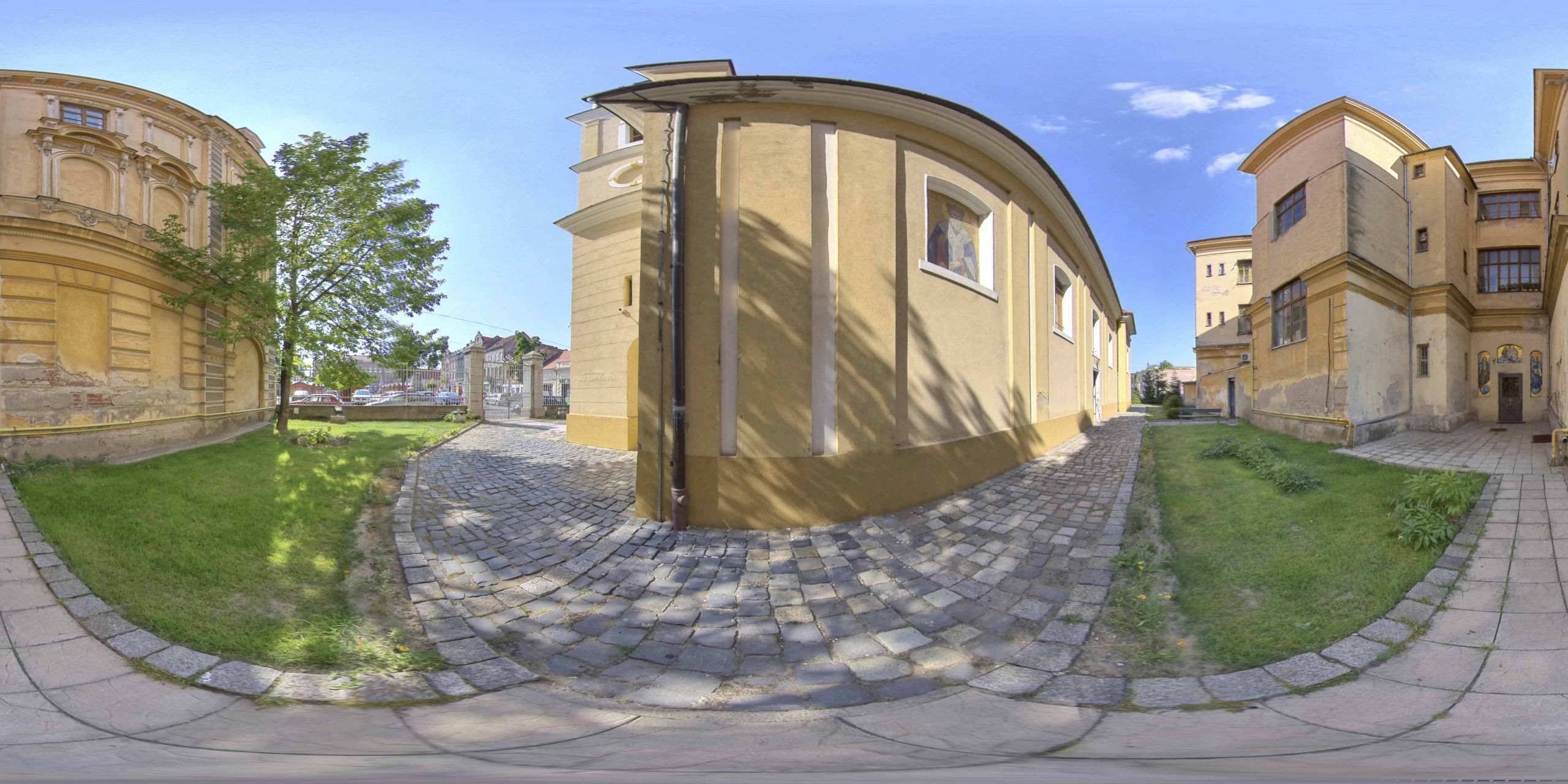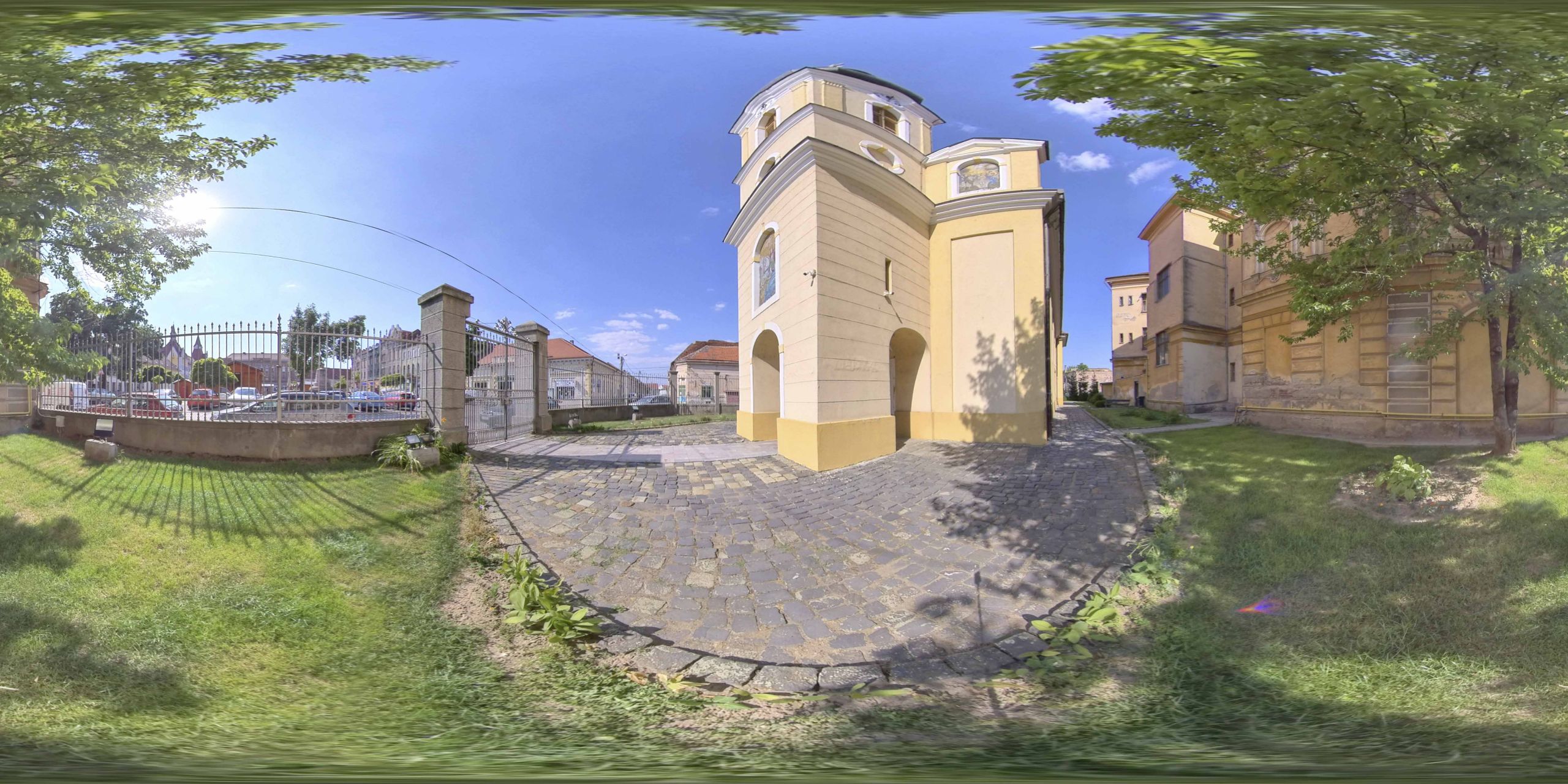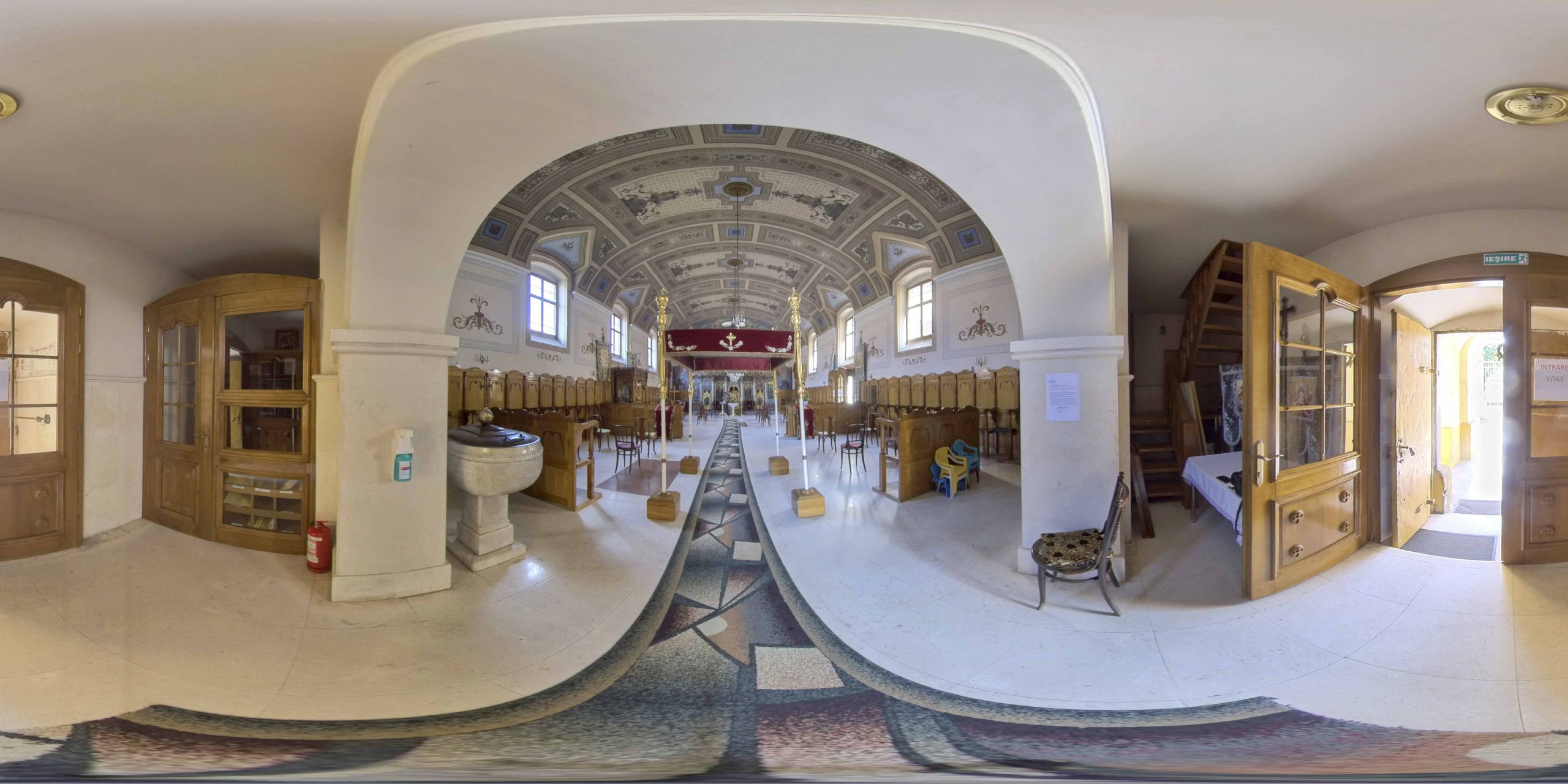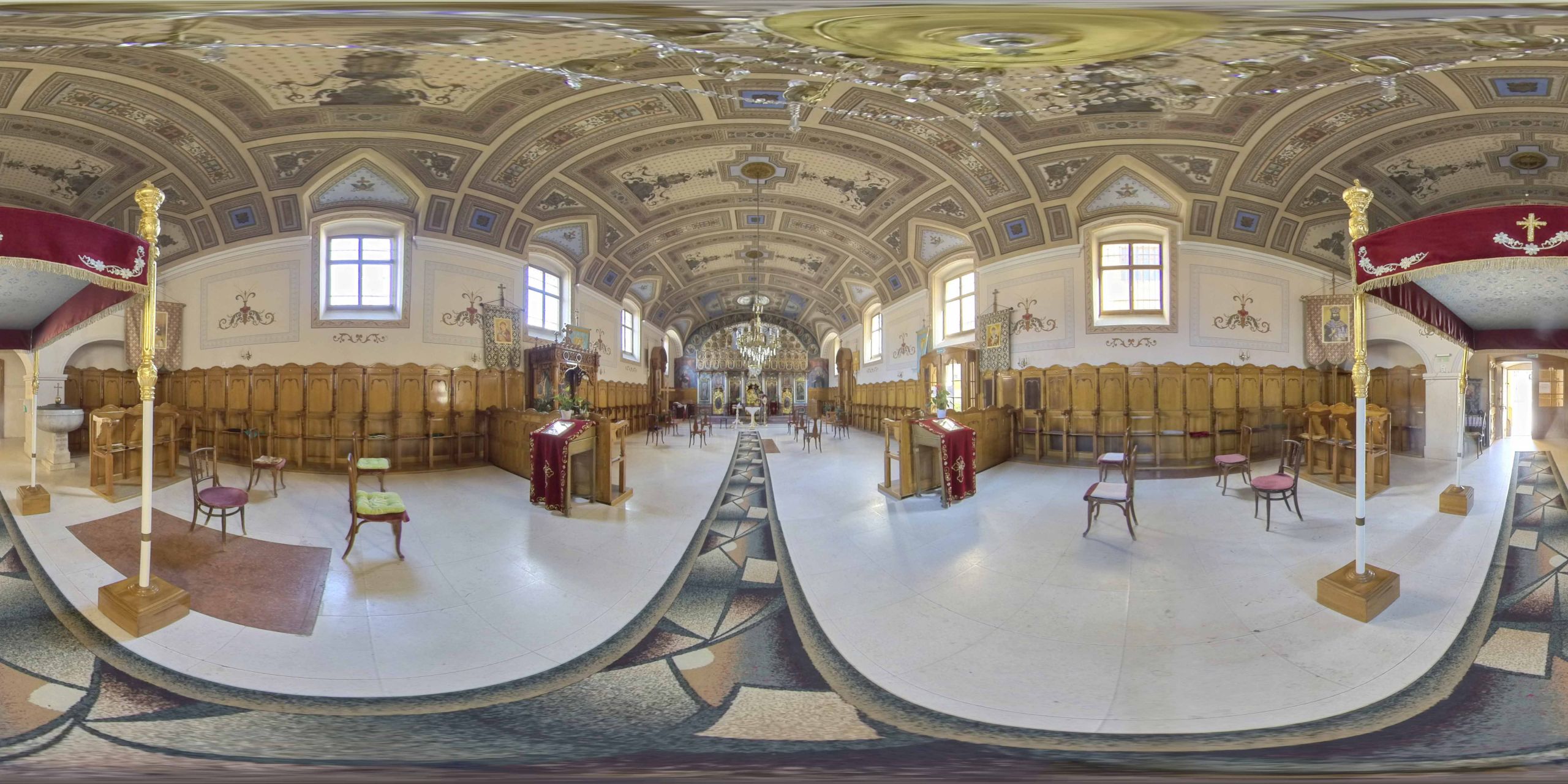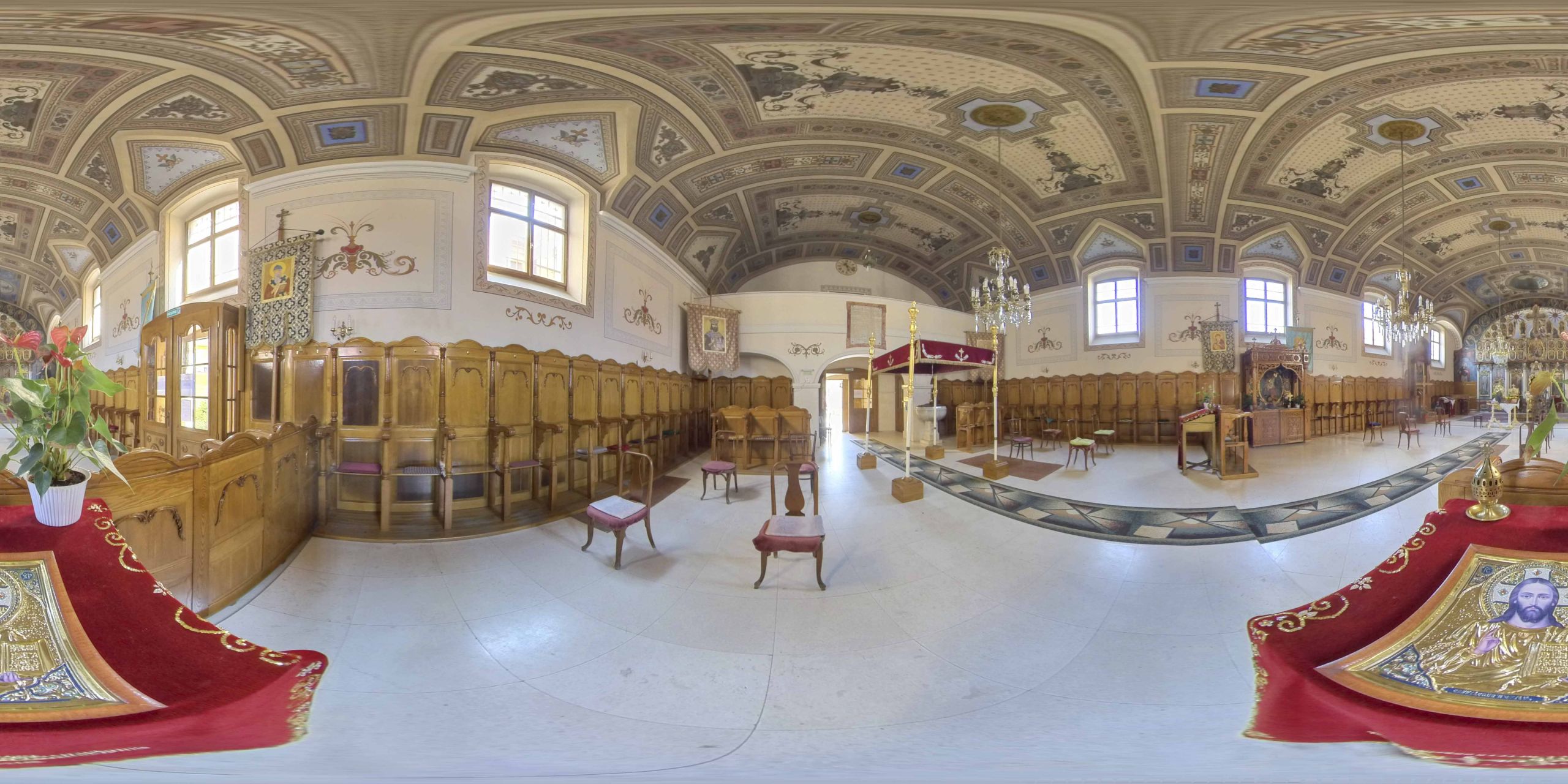Serbian Orthodox Church, Trajan Square no. 1
The current Serbian Orthodox Church in Fabric, dedicated to St. George, was built between 1745-1755. The works most probably started in 1745, a period from which the document referring to the founders of the building dates. In time, the Greek believers were assimilated, and the Romanians separated, de facto in 1863 and legally in 1901, so that the place remained in the care of the Serbian Orthodox community in Fabric.
Listen to the audio version.
The earliest data regarding the existence of an Orthodox church located in the Fabric neighborhood are kept in a parish register from 1727, a document issued during the time of the Metropolitan bishop of Timișoara, Mojsej Petrović. Very limited information is known about this church. In 1737, after the fire that destroyed the Orthodox Church from the Cetate neighborhood, the Church in Fabric became the only place of worship of the Orthodox in the city, here also officiating the Orthodox bishop of Timișoara.
The current Serbian Orthodox Church from Fabric, dedicated to St. George, was built between 1745-1755. The works most probably started in 1745, the period from which the document relating to the edifice dates. At that time, the old church in Fabric was still used by the parishioners and clergy, at least until 1748, when the Orthodox Church from the Cetate neighborhood was completed.
Over time, the ethnic Greek believers were assimilated, and the Romanians separated, factually in 1863 and legally in 1901, so that the place remained in the care of the Serbian Orthodox community from Fabric.
The church, originally built in the baroque style, has a series of classical elements added in the 19th century, also when the tower was raised. The plan is cross-shaped, the building being built of burnt brick and covered with tiles. The tower, attached to the western side of the church, was built on four massive pillars that form a beautiful porch at the bottom, at the entrance to the building. In the tower are kept four bells and a clock mechanism. All three access gates are covered with beautiful ornate paintings.
In the absence of period information, we cannot present the initial appearance of the church, given that rehabilitation and redevelopment works have certainly taken place over time. The only certain fact is that the beginning of the century. XX, the tower was rehabilitated, from that period dating the current appearance of the tower.
Valuable icons from the 18th-19th century are preserved in the church, painted by famous artists (Stefan Tenecki, Sava Petrović). There are several tombs, both inside the church and in the courtyard, the most important being that of the senior official from Timisoara, Stojša Spasojević, who erected in 1774 the marble pyramid with a cross, located in front of the church.
Bibliography:
- Stevan Bugarski, Srpsko pravoslavlje u RumunijiTemišvar-Beograd-Novi Sad, 1995, pp. 160-162.
- 5. Mihai Opriș, Mihai Botescu, Historical Architecture in Timișoara, ed. Tempus, 2014
The Serbian Orthodox Church
The Serbs had a strong community in Timişoara, with three churches, and each church had a choir of 30-40 people. Then there were three primary schools: in Fabric, Cetate, and Mehala. After ’32, the Serbian high school was established in the building of the Diaconovici Loga Highschool, by agreement between the two states. We had classes before lunch, whereas Serbian students, after lunch.
There was also the Serbian Women’s Association, which was a strong association, helping the poor, women with many children, and women in distress. They would organize a show once a month in the Episcopal Palace, with choirs, tambouras, songs, and poems.
The community also had a library, both in Fabric and in Cetate. The church community was well-off, as the one in Fabric had three large buildings, owned by the church. The rent money was used to cover church expenses, to pay the teachers, the priest. Likewise, the community in Cetate had two very large buildings; only the community in Mehala was less fortunate.
Were there any clubs or places where Serbs met? Yes, for instance, when the choir in Cetate had a rehearsal in the evening, then they would go to Spieluhr restaurant, where there’s the Museum of the Revolution (Muzeul Revoluţiei)now, on Gheorghe Lazăr Street. If there were men in the choir, then their wives were already there waiting for them, or vice versa.
The Serbs have this religious feast day, which is the largest religious family feast, called the Patron Saint of the House. Every house has a patron saint, and mine is St. Nicholas. We lived in Traian Square and when my grandparents and parents were still alive, they used to go to church on St. Nicholas’ Day, and then friends would come by to wish us well. Back then, before the war, 40-50 people used to come there on this occasion. The priest would also come by on that day, to sanctify your home. We say a short prayer, for five minutes. This comes from our ancestors and every Serbian family has a saint as the patron of the house, who protects them.
We also used to go to our acquaintances and friends, so there were about 15-17 such gatherings in a year when we paid each other visits.
I have no idea why my family has chosen this patron, but I do know that each family has a saint and this is more important to Serbs than Christmas, than the New Year, than anything. On that day, you must go to church and you must treat those closest to you at home.
Vladimir Nenadovici, born in 1923 in Timișoara – excerpt from an interview by Adrian Onică, Timișoara 2003, The oral history and anthropology group archive, coordinated by Smaranda Vultur.
Were you the youngest daughter? Yes, my brother is four years older. He was born in '26 and I was born in '30. My parents lived in a small family house on Samuel Micu Street, which is just around the corner from Matei Corvin Street, opposite of the Glove Factory. I grew up living there for seven years. Now, they seem to have made a shop halfway through the house. That's how I always look at it, as if with longing, and I remember how much I used to play on that street... It was a street mostly inhabited by Serbs? There were all the nationalities of the world. On the corner there was a grocery owner, a German, who had two daughters, one of them was Mina. And I used to play with Mina, with dolls, with... I spoke German with her. On Simion Bărnuțiu Street, around the corner, there was Soruța Baloș, who was Romanian, daughter of a teacher. I used to play with her as well. Across the street lived the baker's daughter, who was my classmate in first grade. I spoke Hungarian with her.. I can't even tell you how many languages were spoken! Our maids - that's how I learned Hungarian - were always Hungarian. My mother preferred them, because she said that the Swabians were too close to home, and they could steal and take away. The Hungarian girls, they all came from Szekler. My mother knew Hungarian well, because they spoke Hungarian in Novi Sad, and my father knew it because he had gone to school during the Austro-Hungarian period. My mother spoke four languages and my father spoke five or six, or rather, because at the end of his career he was a translator at the State Notary's Office for five languages: Serbian, French, Hungarian, German, Czech.
On the other hand, my parents were very keen for us to learn languages. They realised how important it is to speak foreign languages, no matter what language. And my mother used to say: "Today we speak German in the house!" And all day long we had to speak only German: to ask, to answer in German. "Today we speak Hungarian!"... Well, Serbian was spoken all the time. And we also spoke Romanian, sometimes, so my mother would learn Romanian. My father didn’t know it perfectly either, but he knew incomparably better. As a child, in the area where he lived, Iuliu Grozescu Street – opposite of the Romanian church in Fabric, there were all nations, including Jews. And they used to play with their children there, and when it was cold, in the winter, they would go into the Jewish synagogue, because there was a Jewish synagogue in the area. And they had to have at least seven people there to start the evening service. And that rabbi counted everyone, including my father, who was not Jewish, saying: "We are seven, we can start!" (laughs) I know my father used to tell me, with laughter, about that. So, all the nationalities were in Timisoara. That was typical, characteristic.
How did your parents get along with neighbours of another ethnicity? Very well! Was there any difference? Absolutely no difference. That's how I was used to it: whoever we met on the street, I had to greet and speak the language of the person's nationality. If they were German - "Guten Tag..." – I spoke German. "If it was Hungarian the same, if it was Romanian: "Ce mai faceți...". This was ordinary. So you were speaking in the language of the nationality of the person you were meeting. Officially, it was something entirely different. When we were going somewhere, then we would speak Romanian, that was known. That's what it was.
Xenia Manojlovic, born in 1930 in Timișoara - excerpt from an interview conducted by Simona Adam in Timișoara in 2002, The oral history and anthropology group archive, coordinated by Smaranda Vultur.
It is about defending this city that belongs to all of us who live here, whether we are Romanians, Gypsies, Hungarians, Serbs, Jews or whatever we may be, but this city, because we are talking about the spirit of Timișoara, can be found, beyond what came new, good or bad, after the Revolution, it can be found in the authenticity of an imperial or interwar period heritage, and through the respective architectural styles, of a particular refinement. Through that Jugendstil, through that Baroque, through those ornaments that can still be found in the Fabric district, through those anonymous buildings, on the bank of the Bega river, or on the streets, like Tigru Street or on the little streets that branch off from Traian Square, yes, these still can be found... Where is the Synagogue, one of the synagogues of the Fabric district, not the big one next to Enel, but a small one, which has been rented, it seems to me, and has had its exterior appearance altered?... But I often go there, out of nostalgia, where there was a Jewish school in my childhood and where there is a plaque on a gate that still says Talmud School, this inscription still exists there... It's on a street, I think on Ion Creangă Street or Ispirescu Street. I went there once, a long time ago, with Vighi and Marineasa. It's an area where there are still small islands of the authentic Fabric neighbourhood where, as they say, these houses still preserve the ornamentation of the interwar period and before the Union. And they have their charm, see those angels, see those...
- Bas-reliefs? – - Yes, those bas-reliefs, gables, those solid wooden gates, the bronze or austere metal latches, wrought iron (carved), those still exist, those are still preserved, but less and less, that something that has a certain poetry, a mark of passing time, of history...There is still to be found in the spirit of Timișoara, with a special poetry of the old streets and which should not be lost, only by virtue of a so-called new planning, systematization of Timișoara in the 21st century... It is not acceptable that Timișoara, which we keep invoking as a special place with a spirit of its own, to slowly and irreversibly disappear."
Eugen Bunaru (born in Timișoara 1945). Excerpt from the interview conducted by Aurora Dumitrescu in 2004, Timișoara, , The oral history and anthropology group archive, coordinated by Smaranda Vultur.
The Serbs had a strong community in Timişoara, with three churches, and each church had a choir of 30-40 people. Then there were three primary schools: in Fabric, Cetate, and Mehala. After ’32, the Serbian high school was established in the building of the Diaconovici Loga Highschool, by agreement between the two states. We had classes before lunch, whereas Serbian students, after lunch.
There was also the Serbian Women’s Association, which was a strong association, helping the poor, women with many children, and women in distress. They would organize a show once a month in the Episcopal Palace, with choirs, tambouras, songs, and poems.
The community also had a library, both in Fabric and in Cetate. The church community was well-off, as the one in Fabric had three large buildings, owned by the church. The rent money was used to cover church expenses, to pay the teachers, the priest. Likewise, the community in Cetate had two very large buildings; only the community in Mehala was less fortunate.
Were there any clubs or places where Serbs met? Yes, for instance, when the choir in Cetate had a rehearsal in the evening, then they would go to Spieluhr restaurant, where there’s the Museum of the Revolution (Muzeul Revoluţiei)now, on Gheorghe Lazăr Street. If there were men in the choir, then their wives were already there waiting for them, or vice versa.
The Serbs have this religious feast day, which is the largest religious family feast, called the Patron Saint of the House. Every house has a patron saint, and mine is St. Nicholas. We lived in Traian Square and when my grandparents and parents were still alive, they used to go to church on St. Nicholas’ Day, and then friends would come by to wish us well. Back then, before the war, 40-50 people used to come there on this occasion. The priest would also come by on that day, to sanctify your home. We say a short prayer, for five minutes. This comes from our ancestors and every Serbian family has a saint as the patron of the house, who protects them.
We also used to go to our acquaintances and friends, so there were about 15-17 such gatherings in a year when we paid each other visits.
I have no idea why my family has chosen this patron, but I do know that each family has a saint and this is more important to Serbs than Christmas, than the New Year, than anything. On that day, you must go to church and you must treat those closest to you at home.
Vladimir Nenadovici, born in 1923 in Timișoara – excerpt from an interview by Adrian Onică, Timișoara 2003, The oral history and anthropology group archive, coordinated by Smaranda Vultur.
